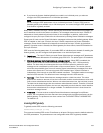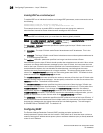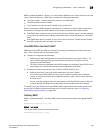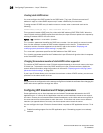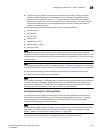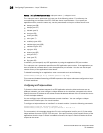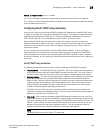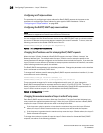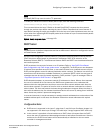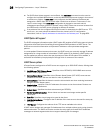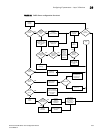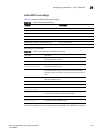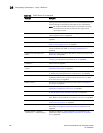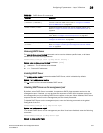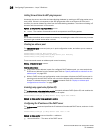
PowerConnect B-Series FCX Configuration Guide 841
53-1002266-01
Configuring IP parameters – Layer 3 Switches
26
NOTE
The BootP/DHCP hop count is not the TTL parameter.
To modify the maximum number of BootP/DHCP hops, enter the following command.
PowerConnect(config)# bootp-relay-max-hops 10
This command allows the Layer 3 Switch to forward BootP/DHCP requests that have passed
through ten previous hops before reaching the Layer 3 Switch. Requests that have traversed 11
hops before reaching the switch are dropped. Since the hop count value initializes at zero, the hop
count value of an ingressing DHCP Request packet is the number of Layer 3 routers that the packet
has already traversed.
Syntax: bootp-relay-max-hops <1 through 15>
DHCP Server
NOTE
The DHCP server is platform independent and has no differences in behavior or configuration across
all PowerConnect platforms .
Dynamic Host Configuration Protocol (DHCP) is a computer networking protocol used by devices
(DHCP clients) to obtain leased (or permanent) IP addresses. DHCP is an extension of the
Bootstrap Protocol (BOOTP). The differences between DHCP and BOOTP are the address allocation
and renewal process.
DHCP introduces the concept of a lease on an IP address. Refer to “How DHCP Client-Based
Auto-Configuration and Flash image update works” on page 856. The DHCP server can allocate an
IP address for a specified amount of time, or can extend a lease for an indefinite amount of time.
DHCP provides greater control of address distribution within a subnet. This feature is crucial if the
subnet has more devices than available IP address. In contrast to BOOTP, which has two types of
messages that can be used for leased negotiation, DHCP provides 7 types of messages. Refer to
“Supported Options for DHCP Servers” on page 859.
DHCP allocates temporary or permanent network IP addresses to clients. When a client requests
the use of an address for a time interval, the DHCP server guarantees not to reallocate that
address within the requested time and tries to return the same network address each time the
client makes a request. The period of time for which a network address is allocated to a client is
called a lease. The client may extend the lease through subsequent requests. When the client is
done with the address, they can release the address back to the server. By asking for an indefinite
lease, clients may receive a permanent assignment.
In some environments, it may be necessary to reassign network addresses due to exhaustion of the
available address pool. In this case, the allocation mechanism reuses addresses with expired
leases.
Configuration Notes
• DHCP server is supported in the Layer 2, edge Layer 3, and full Layer 3 software images. It is
not supported in the base Layer 3 image. The base Layer 3 image supports DHCP client only.
• In the event of a controlled or forced switchover, a DHCP client will request from the DHCP
server the same IP address and lease assignment that it had before the switchover. After the
switchover, the DHCP Server feature will be automatically re-initialized on the new active
controller or management module.



